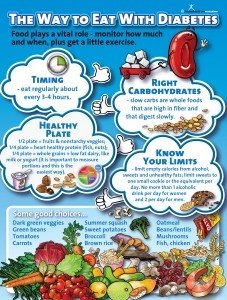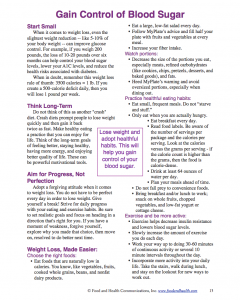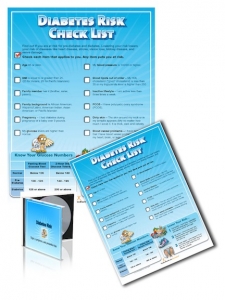Gain Control of Your Blood Sugar
 According to the American Diabetes Association, 29.1 million people in the United States have diabetes. Whether you have diabetes already, just got a diagnosis of prediabetes, or have a history of diabetes in your family, then you should know that you can take steps to control your blood sugar. Weight loss is a key component, as are dietary changes. Let's take a closer look at exactly how you can gain control of your blood sugar...Start SmallWhen it comes to weight loss, even the slightest weight reduction -- like 5-10% of your body weight -- can improve glucose control. For example, if you weigh 200 pounds, the loss of 10-20 pounds over six months can help control your blood sugar levels, lower your A1C levels, and reduce the health risks associated with diabetes.When in doubt, remember this weight loss rule of thumb: 3500 calories = 1 lb. If you create a 500-calorie deficit daily, then you will lose 1 pound per week.Think Long-TermDo not think of this as another "crash" diet. Crash diets prompt people to lose weight quickly and then gain it back twice as fast. Make healthful eating a practice that you can enjoy for life. Think of the long-term goals of feeling better, staying healthy, having more energy, and enjoying better quality of life. These can be powerful motivational tools.Aim for Progress, Not PerfectionAdopt a forgiving attitude when it comes to weight loss. You do not have to be perfect every day in order to lose weight. Give yourself a break! Strive for daily progress with your eating and exercise habits. Be sure to set realistic goals and focus on heading in a direction that's right for you. If you have a moment of weakness, forgive yourself, explore why you made that choice, then move on, resolved to do better next time.Choose the Right Foods:
According to the American Diabetes Association, 29.1 million people in the United States have diabetes. Whether you have diabetes already, just got a diagnosis of prediabetes, or have a history of diabetes in your family, then you should know that you can take steps to control your blood sugar. Weight loss is a key component, as are dietary changes. Let's take a closer look at exactly how you can gain control of your blood sugar...Start SmallWhen it comes to weight loss, even the slightest weight reduction -- like 5-10% of your body weight -- can improve glucose control. For example, if you weigh 200 pounds, the loss of 10-20 pounds over six months can help control your blood sugar levels, lower your A1C levels, and reduce the health risks associated with diabetes.When in doubt, remember this weight loss rule of thumb: 3500 calories = 1 lb. If you create a 500-calorie deficit daily, then you will lose 1 pound per week.Think Long-TermDo not think of this as another "crash" diet. Crash diets prompt people to lose weight quickly and then gain it back twice as fast. Make healthful eating a practice that you can enjoy for life. Think of the long-term goals of feeling better, staying healthy, having more energy, and enjoying better quality of life. These can be powerful motivational tools.Aim for Progress, Not PerfectionAdopt a forgiving attitude when it comes to weight loss. You do not have to be perfect every day in order to lose weight. Give yourself a break! Strive for daily progress with your eating and exercise habits. Be sure to set realistic goals and focus on heading in a direction that's right for you. If you have a moment of weakness, forgive yourself, explore why you made that choice, then move on, resolved to do better next time.Choose the Right Foods:
- Eat foods that are naturally low in calories. You know, like vegetables, fruits, cooked whole grains, beans, and nonfat dairy products.
- Eat a large, low-fat salad every day.
- Follow MyPlate’s advice and fill half your plate with fruits and vegetables at every meal.
- Increase your fiber intake.
Watch Portions:
- Decrease the size of the portions you eat, especially meats, refined carbohydrates (like cookies, chips, pretzels, desserts, and baked goods), and fats.
- Heed MyPlate’s warning and avoid oversized portions, especially when dining out.
Practice Healthful Eating Habits:
- Eat small, frequent meals. Do not “starve and stuff.”
- Only eat when you are actually hungry.
- Eat breakfast every day.
- Read food labels. Be aware of the number of servings per package and the calories per serving. Look at the calories versus the grams per serving - if the calorie count is higher than the grams, then the food is calorie-dense.
- Drink at least 64 ounces of water per day.
- Plan your meals ahead of time.
- Do not fall prey to convenience foods.
- Bring breakfast and/or lunch to work; snack on whole fruits, chopped vegetables, and low-fat yogurt or cottage cheese.
Exercise and be More Active:
- Exercise helps decrease insulin resistance and lowers blood sugar levels.
- Slowly increase the amount of exercise you do each day.
- Work your way up to doing 30-60 minutes of continuous activity or several 10 minute intervals throughout the day.
- Incorporate more activity into your daily life. Take the stairs, walk during lunch, and stay on the lookout for new ways to work out.
Because it's American Diabetes Month, and because I love ya, here's a free classic handout with the details from this post. Looking for more? Visit the Nutrition Education Store! It's chock-full of diabetes education materials...
Looking for more? Visit the Nutrition Education Store! It's chock-full of diabetes education materials...


